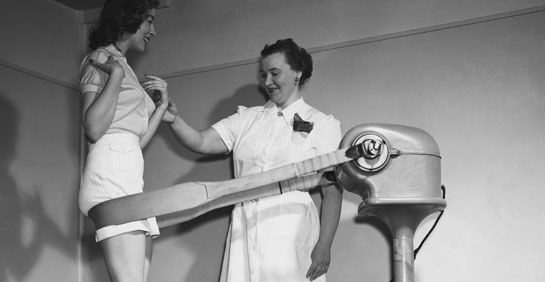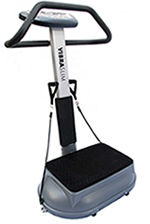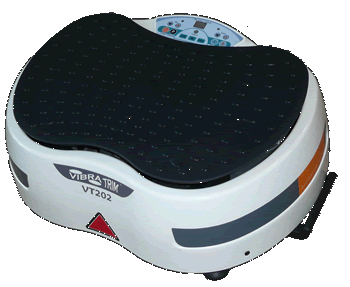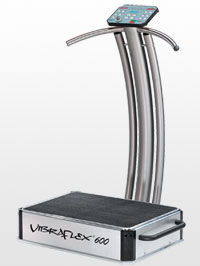
By CARRIE MYERS
Remember those old videos and photos of women standing on “reduction machines,” belts around their derrieres and bellies, attempting to shake the fat off their bodies? Turns out…they may have been onto something.
The idea of increasing the benefits of strength training through what’s now called whole body vibration (WBV) has been gaining attention from researchers, and WBV can now be found in various training programs, from the NFL to NASA, as well as gyms and rehab centers. But the idea of strengthening your muscles using vibrations is really nothing new. The idea first evolved back in the 1960s when Soviet scientists developed techniques that would allow their cosmonauts to endure the rigors of space travel for longer periods of time. After all, a major side effect of a no-gravity environment is muscle atrophy and bone loss. Vibration training allowed them to spend an average of 400 days in space, compared to the American astronauts’ 130 days.
Since then, vibration-training techniques have been tweaked and honed and designed specifically for us everyday Earth-dwellers.
Who Should Avoid WBV Training?
Whole-body vibration training isn’t for everyone. The vibrations may affect pacemakers and other electronic implants. Women who are pregnant or anyone with a history of tumors, thrombosis, or seizures should avoid WBV training.
What Is WBV Training and How Does It Work?
The most popular form of WBV training involves standing on a vibrating platform that has handles attached to it. You can simply stand on the platform and hang out for several minutes, or you can perform squats, lunges, push-ups and the like on the platform. The platform produces oscillating vibrations that are in turn delivered to the entire body. The body part nearest the platform will receive the greatest amount of vibrations, so if you’re standing on it, the lower body will receive more benefits than the upper body.
The vibrations are set at a specific frequency and amplitude. Frequency is measured in hertz (Hz) and refers to the number of vibrations per second. For example, at 25 Hz, the targeted muscles will receive 25 cycles of vibration per second, which means they’ll contract and relax 25 times each second. The amplitude is measured in millimeters (mm) and refers to the extent of the vertical displacement of the platform during vibrations. The higher the frequency and amplitude, the greater the intensity and work on the muscles.

Scientists believe that WBV stimulates the body’s stretch reflex, causing muscle contractions in much the same way that hitting the area just under your patella stimulates the reflex, causing a knee-jerk reaction. The result? WBV training recruits the hard-to-train fast-twitch (type 2) muscle fibers, resulting in increased strength and power.
Rodney Corn, M.A., a personal trainer from Yuba City, Calif., has used whole-body vibration training for both personal use and with his clients for several years. “I use it for a variety of things from both a static and dynamic movement perspective,” he says, “including muscle recovery and regeneration, strength, power and flexibility enhancement, metabolic training, postpartum pelvic floor reconditioning, and bone enhancement.”
Aside from the results your clients will likely see, WBV training can have a positive impact on your financial bottom line, as well.
According to Corn, because it takes less time with WBV to get the same results you will get with traditional training, most WBV training sessions are between 15 and 30 minutes. He charges $25 for a 15-minute session and up to $45 for 30 minutes.
“[When you use a WBV platform with] a cable unit attached, it is also very easy to do small group training,” adds Corn, “either entirely with WBV or as an integrated session using other pieces of equipment.”
This, of course, will just further add to your bank account, as Corn and his colleagues charge $35 to $40 per person for 30-minute small-group WBV training.

What to Look for When Purchasing a WBV Platform
There is a wide range of quality among WBV units, and they come in various sizes with a variety of options, so it is important to physically try the unit out before making a decision. Here are a few points to take into consideration when purchasing a WBV platform.
- Noise level. Some units are extremely noisy.
- Construction material. Plastic is not likely to hold up as long as metal.
- Options. While this is a preference thing, keep in mind that too many bells and whistles provide an opportunity for more parts to break. However, you should be able to choose various frequencies and amplitudes.
- Training. The unit should come with a complete manual and, preferably, in-person training with a knowledgeable company sales rep. At the very least, a training video should also be included with the package.
- Warranty. The unit should come with a good basic warranty, and offer an extended warranty for a reasonable fee.
- Reputation. Many WBV companies have already come and gone so it’s important to know the status and reputation of the company you are considering. Is the company a leader in the field? How long has it been around? The company should also have exceptional customer service that will answer your questions and get you what you need as quickly as possible.
But What Does the Research Show?
There have been many studies examining whole body vibration, most of them showing very promising results. The majority of studies done on muscular strength show that WBV training is at least as effective as traditional strength training, and perhaps even more so if the goal is an increase in power.
A 2007 study in the Journal of Sports Science and Medicine showed that six weeks of WBV training produced significant changes in spring running kinematics and explosive strength performance. Another study in the Journal of Strength and Conditioning Research (2006) suggests that WBV training may increase vertical jump height. And an earlier study published in Medicine & Science in Sports & Exercise (2003) showed WBV training was as effective in increasing strength in untrained females’ knee extensors as moderate resistance training.
Increasingly, WBV studies are focusing on older adults, showing promise for a population that may otherwise have a difficult time with traditional strength training. The Journal of the American Geriatric Society (2004) published a study that showed WBV training was more effective than resistance training in improving knee-extension strength, speed of movement and countermovement jump height in older women. In fact, speed of movement was only seen in the WBV training group. Other studies published in the Journal of Bone and Mineral Research (2004), and in Gait & Posture (2007) show increases in bone density, postural control, balance and mobility in the aging population.
A newer area of WBV study is focused on its effects on body composition. Preliminary data published in the 2010 online publication, Obesity Facts, showed that WBV training may have the potential to be more effective than aerobic exercise for reducing visceral adipose tissue in obese adults. And among older women, Fjeldstad and colleagues (2009) showed that resistance training alone and with WBV training resulted in positive body-composition changes by increasing lean tissue; however, only the combination of resistance training with WBV training was effective for decreasing body fat.
Whole-body vibration training is also showing promise clinically in, for example, the treatment of individuals with spinal cord injury (Restorative Neurology and Neuroscience, 2009), fibromyalgia (The Journal of Alternative and Complementary Medicine, 2008), arterial stiffness, which increases one’s risk of cardiac infarction and stroke (Acta Physiologica, 2008), and anterior cruciate ligament reconstruction (British Journal of Sports Medicine, 2008).
Are the Benefits Worth the Cost of the Equipment?
Cedric X. Bryant, Ph.D., Chief Science Officer for ACE, agrees with Corn that, “given the available scientific evidence, WBV exercise training appears to be a viable alternative or supplement to conventional resistance training for enhancing muscular fitness, bone density and balance.”
However, Bryant is not sure the cost, which averages between $5,000 and $10,000 per unit, is worth the results. “From the published research I’ve reviewed,” explains Bryant, “I’m not sure the improvements are significant enough to justify the relatively high expense.”
While WBV training shows promise and may be a worthwhile program supplement for some people, more time—and more research—may be needed to demonstrate that it can be as cost-efficient as it is results-oriented.

Vibration Training Companies
“Not all vibration is equal,” explains Corn. “Vertical vibration that ranges from 25 to 50 Hz is preferable to the body and is what has been used in all research. Also make sure you get educated on the concept of vibration training and the product you will use.”
Below is a sampling of the companies currently selling vibration units. It is important to fully research each one prior to making a major purchase such as this one (while cost varies, you’re likely to spend upwards of $10,000 for a good commercial unit).
Power Plate Vibra Trim
Vibra Slim VibraFlex
References
Alentorn-Geli, E. et al. (2008). Six weeks of whole-body vibration exercise improves pain and fatigue in women with fibromyalgia. The Journal of Alternative and Complementary Medicine, 14, 8, 975–981.
Bogaerts, A. et al. (2007). Effects of whole-body vibration training on postural control in older individuals: A 1-year randomized controlled trial. Gait & Posture. 26, 309–316.
Cormie, P., Deane, R.S., Triplett, N.T. and McBride, J.M. (2006). Acute effects of whole body vibration on muscle activity, strength and power. Journal of Strength and Conditioning Research, 20, 2, 257–261.
Delecluse, C., Roelants, M.R. and Verschueren, S.M. (2003). Strength increase after whole-body vibration compared with resistance training. Medicine & Science in Sports & Exercise, 35, 6, 1033–1041.
Fjeldstad, C., Palmer, I.J., Bemben, M.G. and Bemben, D.A. (2009). Whole-body vibration augments resistance-training effects on body composition in postmenopausal women. Maturitas, 63, 1, 79–83.
Moezy, A. et al. (2008). A comparative study of whole-body vibration training and conventional training on knee proprioception and postural stability after anterior cruciate ligament reconstruction. British Journal of Sports Medicine, 42, 5, 373–378.
Ness, L.L. and Field-Fote, E.C. (2009). Effect of whole-body vibration on quadriceps spasticity in individuals with spastic hypertonia due to spinal cord injury. Restorative Neurology and Neuroscience, 27, 6, 623–633.
Ness, L.L. and Field-Fote, E.C. (2009). Whole-body vibration improves walking function in individuals with spinal cord injury: A pilot study. Gait & Posture, 30, 4, 436–440.
Otsuki, T. et al. (2008). Arterial stiffness acutely decreases after whole-body vibration in humans. Acta Physiologica, 194, 3, 189-194.
Paradisis, G. and Zacharoqiannis, E. (2007). Effects of whole-body vibration training on sprint running kinematics and explosive strength performance. Journal of Sports Science and Medicine, 6, 44–49.
Roelants, M.R., Delecluse, C. and Verschueren, S.M. (2004). Whole-body vibration training increases knee-extension strength and speed of movement in older women. Journal of the American Geriatric Society, 52, 901–908.
Verschueren, S. et al. (2004). Effect of 6-month whole-body vibration training on hip density, muscle strength and postural control in postmenopausal women: A randomized controlled pilot study. Journal of Bone and Mineral Research, 19, 3, 352–359.
Vissers, D. et al. (2010). Effect of long-term whole-body vibration training on visceral adipose tissue: A preliminary report. Obesity Facts, 3, 2, 93–100.
___________________________________________________________________________
 Carrie Myers has a bachelor’s degree in exercise science and has been a freelance writer for more than 11 years. She is the author of the award-winning book, Squeezing Your Size 14 Self into a Size 6 World: A Real Woman's Guide to Food, Fitness, and Self-Acceptance and presents, teaches and trains in N.H. and Vt.
Carrie Myers has a bachelor’s degree in exercise science and has been a freelance writer for more than 11 years. She is the author of the award-winning book, Squeezing Your Size 14 Self into a Size 6 World: A Real Woman's Guide to Food, Fitness, and Self-Acceptance and presents, teaches and trains in N.H. and Vt.